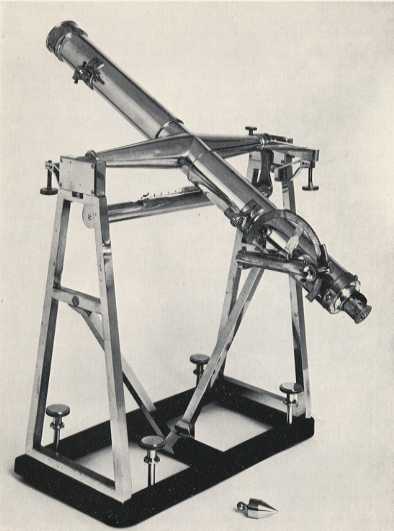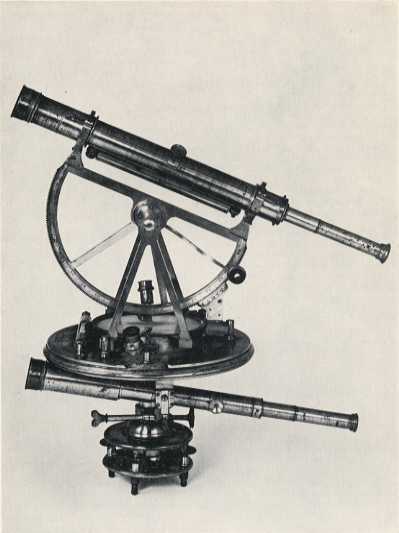
APPENDIX
Description of the Instruments
1 - Portable Transit Instrument

| This instrument, in good conditions, appears to be similar to the one made by J. Ramsden and used by Col. Mudge and others (see note 13) and described in Phil. Trans. 1795, II, page 419. The telescope is 20 1/2 inches (49cm) long and has two conical supports. The achromatic objective lens is 1 3/4 (4.1 cm.) in diameter. The vertical stands are trapezoidal (height 35.3 cm., bases 15.7 and 5.7 cm.) and are reinforced by cross beams connected to the center of the iron-cast base of the instrument, which is rectangular 7 X 13 and 1/4 inches (17.5 X 33 cm.). The main difference from Ramsden's instrument is the apparatus for measuring the inclination angle. This consists in a small level pivoted to the center of a half circle 4 1/4inches (10.5 cm.) in diameter, mounted near the eyepiece and carrying a vernier with 30 divisions which slides on a scale in half degrees. The eyepiece is prismatic. The instrument bears the signature BERGE LONDON on the top face of the base of one vertical stand. It arrived in Palermo on January 1829, as we gather from an expense book of Niccolò Cacciatore, Piazzi's successor. |
2 - Measuring Chains
| Of the four measuring chains delivered in Sept. 1809, only three are extant: two 100' in length and one 50' in length. Their design is identical to those made by Ramsden for Col. Mudge in 1791, and described in the above mentioned paper at page 423. The 100', chains consist of 40 steel links, each 2 and 1/2inches in length and of square cross section with 3/10inches sides. The links are held together by means of two 1 1/8inches (2.8 cm.) plates pinned to the ends of the links (one on each side) in such a way as to leave the links free to rotate around the joining pins. At every fifth link, the joint is at right angles with the preceding one, so as the chains may be neatly folded into a small wooden box. The handles (one at each end) carry a small steel blade with an end gauge mark. They are both signed BERGE LONDON and bear the numbers 13 and 12 near the signature. The 50' chain is identical to the above described 100' chains the only difference being in the number of links which in this case is 20. The brass handles, inscribed BERGE LONDON bear the number 15. The chains came with a complete apparatus for operating them, including supports, weights, etc. |
3 - Pantograph
| This pantograph, preserved in its mahogany case with all its accessories, arrived in Palermo in January 1827. It has an overall length of 33 and1/2inches (85 cm.). Of the four brass arms, the central, marked D, bears a scale of proportions from 1: 12 to 1: 1/2 against which a heavy round weight may be set to supply the center pivot for the instrument. A corresponding scale is marked on the pointer arm marked B. It bears the signature "Berge London Late Ramsden". |
4 - Achromatic Telescope
| The telescope is in mahogany and brass, with a mahogany tripod stand. The barrel (mahogany) is 37" long. It is apparently complete with original object lenses, consisting of a combination of a biconvex and a piano-concave lens. The eyepiece, mounted in brass, is of the triple lens type and bears the signature "Berge London Late Ramsden". The instrument, which arrived in Palermo after the death of Piazzi, together with the transit and other instruments, is in good condition with the exception of the joint for the attachment to the tripod. |
5 - Altitude Barometers
| Two altitude barometers in brass, mahogany, and box-wood, are respectively marked A and B on the cistern and on the tripod stand. They are similar to one made by Ramsden and used by gen. Roy for his experiments "in order to obtain a rule for measuring heights" and described in Phil. Trans. Vol. 67 (1777). A straight brass tube axed in a box-wood cistern carries a small thermometer fixed to the bottom of the tube, bearing a scale for the thermometrical corrections. The barometer's readings are made with the aid of a vernier divided in fifty parts, which slides on the scale along the tube. The tube is signed in italics "Berge London Late Ramsden". An ivory float, swimming on the surface of the mercury, bears a mark which is made to coincide with a gauge mark on the cistern by means of a brass screw at the bottom of the cistern itself. The tripod stand, in mahogany, is hollowed out so as to contain the barometer in an upside position when not in use, together with the keys which are used to operate it. It is held closed by means of two brass rings. The two barometers were probably delivered in 1809, but not later than 1813. They are in good condition apart from the loss of three of the original keys and of two of the closing rings. |

| This theodolite is characterized by two parallel plates and a recessed screw for attachment to the staff. On the limb of the lower plate (9 inches in diameter) is a degree scale, engraved on silver (0-180 X 2), which can be read in conjunction with two opposite verniers set in the upper plate. Microscopes are provided for more precise readings. Below the lower plate, a collar with a wing headed screw for clamping and a small telescope are supplied. The telescope can be rotated indipendently by means of a micrometer screw. The upper plate carries two small spirit levels, set at right angles, and, at its center, a silvered compass with a 8 point rose and a degree scale on the outer raised circumference. The toothed semi-circular vertical are of the instrument carries on one side a degree scale on silver (80-0-65) which can be read against a fixed vernier by the aid of a microscope; on the other side are two scales (30-0-30 and 100-0-100) marked "Diffe of Hypo & Base" and "Perps. in 100th of Base" for direct height and distance measurements. The telescope rests on two Y shaped supports with hinged clips fastened to the instrument by strings. A spirit level is mounted below the telescope between the supports. Both telescopes are focussed with a rack and pinion mechanism. The vernier plate bears the inscription "Berge London Late Ramsden". This instrument, in good condition, is preserved in its original octagonal mahogany case. It was made in 1812 as we gather from a letter dated Oct. 26 1812, and was paid 250 pounds. |
7 - Two Beam Compasses
| They are preserved in their original mahogany case, complete of all accessories and in very good condition. They are both in mahogany with one brass axed end and a sliding brass cursor. They are 46 1/2 inches (119 cm.) long and 2 X 3 3/4 inches (9.5 X 5 cm.) in section. One of them has inlaid a box-wood stripe carrying a graduation in inches and tenths of an inch, and marked BERGE LONDON. Sharpened cylindrical rods can be attached to the brass fixtures and accurate positioning is achieved by means of lenses. Reading accuracy of one hundredth of a inch is obtained in the graduated compass by means of a vernier engraved on its cursor. |
8 - Compass with sights
| This instrument, with recessed screw for attachment to the staff, consists essentially of a silvered compass 5 inches (12.5 cm.) in diameter with a 8 point rose and a degree scale on the raised circumference. The compass can be rotated both manually and by means of a micrometer screw. A small telescope 16 inches long (41 cm.) is set above the compass on Y type supports. It rotates jointly to the compass. Inscribed on the quadrant of the compass "Berge London late Ramsden". |
RIASSUNTO
In quest'articolo si discute 1'attribuzione a Matthew Berge, successore di J. Ramsden, di dodici strumenti ritrovati
all'Osservatorio Astronomico di Palermo. Nell'appendice gli autori descrivono brevemente gli strumenti stessi.
RÉSUMÉ
Dans cet article on discute sur une base documentaire 1'attribution d'une série de 12 instruments de mesure, retrouvée à 1'Observatoire Astronomique de Palerme, à Matthew Berge, successeur de J. Ramsden. Il y a une brève description de ces instruments dans 1'appendice.
INHALTSANGABE
In diesem Artikel wird auf dokumentarischer Grundlage die Frage diskutiert, ob eine Serie von zwölf Messinstrumenten, die kürzlich im Astronomischen Observatorium Palermo gefunden wurden, Matthew Berge, Nachfolger von J. Ramsden, zugeschrieben werden kann. Eine kurze Beschreibung der Instrumente ist im Anhang zu finden.